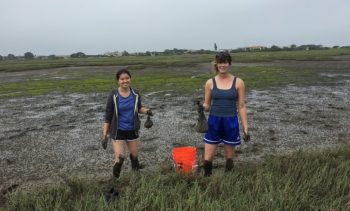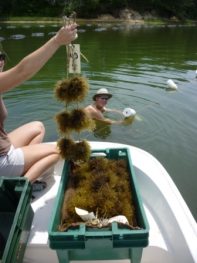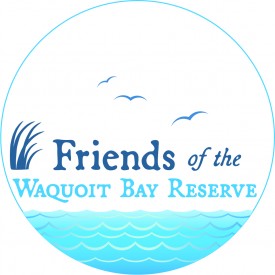Northeast Regional Ocean Council: Initiating new monitoring activities to accelerate implementation of the regional ocean and coastal acidification monitoring plan
Project Title: Northeast Regional Ocean Council (NROC): Initiating new monitoring activities to accelerate implementation of the regional Ocean and Coastal Acidification monitoring plan
Duration: October 2025 – October 2026
Funding Source: NERACOOS
Principal Investigator: Brian Helmuth, Northeastern University
Contact: b.helmuth@northeastern.edu
Project Description: The goal of this project is to identify thermal microhabitats within which shell-forming organisms that are vulnerable to ocean and coastal acidification might take refuge from low pH conditions, and to assess the potential buffering capacity of different habitat types to extreme heat and extreme cold events. We will deploy 10 microsensors within each of three sites within each of five NERR sites, including Waquoit Bay, for a total of 30 sensors per NERR and 150 across the network. Replicate sensor deployments of ElectricBlue ENVloggers will help to characterize the mean and extreme temperatures within hard substrate and soft substrate (marsh) intertidal sites, as well as shallow water sites where eelgrass either currently or historically has existed. Because data can be downloaded from any cell phone, we will also work with the NERR education coordinator to establish citizen science protocols that complement ongoing work at the Waquoit Bay NERR.
Developing a method to survey blue crabs on oyster farms in southern Cape Cod
Project Title: Developing a method to survey blue crabs on oyster farms in southern Cape Cod
Duration: June 2025-December 2025
Funding Source(s): Internal funding from Wellesley College
Principal Investigator: Becca Selden, Wellesley College
Contact: rs5@wellesley.edu
Project Description: As blue crabs are moving poleward with warming waters, they are increasing in abundance at their historic range edge in southern Cape Cod and increasingly being found further north in the Gulf of Maine. Oyster farmers are frequent observers of blue crabs and green crabs in and around their gear. We are interested in developing a survey that could be deployed at oyster farms throughout the region as a sentinel of the blue crab range expansion. We have partnered with oyster farms in Waquoit Bay, Cotuit Bay, and Barnstable to identify protocols for surveying different types of oyster gear and to identify emergent patterns on crab spatial distributions as a function of season and linked to environmental variables collected at nearby water quality sampling stations. In WBNERR we are working with the town of Falmouth oyster farm within Waquoit Bay. We will record the number, size, and sex of crabs on or in their array of floating gear, and relate that to gear design and mesh size. The pilot project will begin in Summer 2025 and sampling will occur monthly throughout the summer and fall of 2025.
Hamblin Pond Oyster Project
Project Title: Hamblin Pond Oyster Project
Duration: June 2025-Aug 2025
Funding Source: The Nature Conservancy, USDA NRCS
Lead Investigator: Daniel GoulartAffiliation, TNC
Contact: daniel.goulart@tnc.org
Project Description: TNC and it’s project partner MA DMF will deploy data loggers at the site of a future oyster reef restoration project in Hamblin Pond, a sub-embayment of Waquoit Bay. The loggers being deployed will monitor dissolved oxygen, conductivity temperature, and depth. Monitoring will provide baseline data ahead of project implementation and ongoing awareness of water quality parameters after shell cultch substrate and live oysters have been deployed.
Exploring the Role of Geukensia demissa in Carbon Sequestration
Project Title: Exploring the Role of Geukensia demissa in Carbon Sequestration
Duration: 8/2025-9/2025
Funding Source(s): ORISE / NECASC supported research
Principal Investigator(s), Julie Walker (NECASC) juliewalker@umass.edu, Erin Peck (URI) erin.peck@uri.edu
Affiliation: Northeast Climate Adaptation Science Center
Project Description: We propose an interdisciplinary approach to explore the role of mollusks in the global C cycle, using Geukensia demissa (ribbed mussels) as a study organism to pilot methods to be applied to other coastal systems containing shellbuilding mollusks. Mollusks sequester inorganic C via biomineralization through the formation of calcium carbonate shells. Calcium carbonate is a more stable form of C than organic C in soils or living biomass, with a residence time in the order of millennia. Still, the amount of calcium carbonate stored in salt marsh sediments over time has yet to be adequately explored. In addition to the inorganic C storage capacity through biomineralization, mussels may contribute significantly to stored organic C through sediment deposition. Ribbed mussels create a large amount of feces and psuedofeces, resulting in increased sedimentation and production of cordgrass via fertilization. With mussel mounds often being persistent on the marsh platform these structures likely have an enduring influence on sediment dynamics. To expound upon the sources and longevity of the C sequestered by ribbed mussels we propose to address three questions: (1) What are the inorganic and organic C contents of salt marsh sediment near mussel mounds, (2) what are the source contributions to inorganic and organic C salt marsh sediment, and (3) how do these source contributions change with depth and time over the last century?
Exposure of marine worms to culture of Alexandrium catenella
Project Title: Exposure of marine worms to culture of Alexandrium catenella
Duration: May 2024 – July 2024
Funding Source(s): WHOI
Principal Investigator and contact info:
Lead Investigator / onsite-contact: Donald Anderson / Sylvain Gaillard
Affiliation: Woods Hole Oceanographic Institution
Email: danderson@whoi.edu / sylvain.gaillard@whoi.edu
Project Description: Toxic species of the dinoflagellate genus Alexandrium can produce toxigenic compounds that can accumulate in filter-feeding organisms, including saxitoxins, responsible for paralytic shellfish poisoning (PSP) in humans. While the toxin pathways have been well characterized in several marine organisms, especially marine bivalves, there is little information on animals indirectly consumed by human or directly consumed traditionally as subsistence food by indigenous populations, which are not monitored for saxitoxin contamination and thus pose a risk of PSP in consumers. Several marine worms have been described as prey items of walrus, a top-predator hunted in northern circumpolar regions of Alaska and Russia. We aim to investigate the uptake, accumulation and depuration of saxitoxin by locally sampled marine worms exposed in vitro to an Alaskan isolate of A. catenella. The results of this study will be directly beneficial for native communities, as well as will improve knowledge of saxitoxin transfer through the food-chain, including to local fish and other animals that consume marine worms.
Efficacy of established and emerging tidal marsh restoration methods
Project Title: Efficacy of established and emerging tidal marsh restoration methods
Lead Investigator: Brian Yellen, UMass Amherst, byellen@umass.edu
Onsite Contact: Sintra Reves-Sohn, UMass Amherst, srevessohn@umass.edu
Project Description: Salt marshes are extremely beneficial to surrounding communities because they provide recreational spaces, control floods, and improve water quality. Salt marshes also effectively store carbon and are home to resident species, such as the endangered saltmarsh sparrow and commercially and culturally important fish stocks. Vegetation is key to salt marsh survival; when the marsh is flooded at high tide, salt marsh vegetation traps sand and mud, which makes it possible for the salt marsh to build upward. This is especially important for salt marsh survival when sea level is rising quickly. If the marsh can’t build elevation, it will be outrun by rising sea levels. In addition to the threat of sea level rise, the Dog’s Head Marsh at Waquoit Bay National Estuarine Research Reserve is vulnerable due to an undersized culvert that was removed in 2008. Pre-removal, the culvert prevented tides from traveling far upstream, causing the once salty ecosystem to “freshen,” which in turn causes the land to subside (become low in elevation). When the culvert was removed in 2008, saltwater flooded this upstream area, which caused the freshwater vegetation to die, and creating a muddy expanse. The aim of this project is to characterize how sediment is moving through Sage Lot Pond and into Dog’s Head Marsh at WBNERR and understand how this relates to how Dog’s Head Marsh’s vegetation has adapted post-culvert removal. With this information, we can better predict how Dog’s Head Marsh will continue to adapt to rising sea level and we can make recommendations to how to best preserve the salt marsh.
salty ecosystem to “freshen,” which in turn causes the land to subside (become low in elevation). When the culvert was removed in 2008, saltwater flooded this upstream area, which caused the freshwater vegetation to die, and creating a muddy expanse. The aim of this project is to characterize how sediment is moving through Sage Lot Pond and into Dog’s Head Marsh at WBNERR and understand how this relates to how Dog’s Head Marsh’s vegetation has adapted post-culvert removal. With this information, we can better predict how Dog’s Head Marsh will continue to adapt to rising sea level and we can make recommendations to how to best preserve the salt marsh.
Evaluating innovative technologies to reduce the impact of septic system contaminants on ecological keystone species
Project Title: Evaluating innovative technologies to reduce the impact of septic system contaminants on ecological keystone species
Duration: 2/2024-2/2026
Funding Source: Woods Hole Sea Grant
Principal Investigator Lead Investigator / onsite-contact: Jed Goldstone, Woods Hole Oceanographic Institution
Project Description: Contaminants of Emerging Concerns (CECs) are a diverse class of compounds with widely varying toxicological and chemical properties, commonly associated with municipal wastewater, urban storm water, agricultural run-off, and other non-point sources, which makes them difficult to monitor and regulate. Important classes of CECs are pharmaceuticals, detected in more than 80% of streams, and in coastal waters, and endocrine disrupting compounds (EDCs). Septic system effluents are a suspected source of CECs to freshwater ponds, aquifers and drinking water supplies, and to coastal waters, because typical septic system designs do not provide much removal efficiency for most CECs. Innovative and alternative (IA) septic system systems designed for nitrogen remediation may provide significant co-benefit removal of CECs, particularly pharmaceuticals and EDCs.
Blue mussels (Mytilus edulis) and ribbed mussels (Geukensia demissa) are foundation species in the New England intertidal that establish and maintain the key habitats that provide essential ecosystem services. However, there is an observed decline of both species in New England (>60% loss of blue mussels since 1970). CECs and EDCs can have biological effects at very low exposure concentrations, have been detected in coastal waters and animal tissue, and may be impacting populations of blue and ribbed mussels. Our work has shown that M. edulis is highly sensitive to pharmaceutical exposures, particularly steroid-like EDCs, and we suggest that these effects extend to closely related Mytilidae species such as G. demissa. The proposed research will examine the effects of septic effluent and septic field leachate on M. edulis and G. demissa sex ratios, and directly test the ability of IA systems to reduce compounds that affect sex gene expression.
Composition, Colonization, and Succession of Trematode Parasites in Estuarine Snail Populations
Title: Composition, Colonization, and Succession of Trematode Parasites in Estuarine Snail Populations
Date: 06/2019 – 08/2022
Principal Investigators: Lauren Dykman
Affiliation: Woods Hole Oceanographic Institution
Email: ldykman@mit.edu

PI: Lauren Dykman (right)
Summary: Hosts function as patchy islands of habitat for parasites. The balance between the colonization and extinction of parasites on individual hosts helps determine the abundance of parasites in host populations. Parasite-host systems, therefore, are useful model systems for understanding how colonization, competition, and habitat age (in this case the age of the host) influence the number, distribution, and turnover of species in island-like systems.
I use a combination of field and laboratory experiments to understand how features of Eastern Mudsnail (Tritia obsoleta) populations (i.e., distribution, movement, and size structure) interact with the biology of their trematode parasites (i.e., colonization and competition) to determine patterns in parasite composition in snail populations in a range of estuaries, including Waquoit Bay.
In New England, nine trematode species use the Eastern Mudsnail as a first host. These worms impact the snail host in a number of ways – they can change its behavior, and they also destroy its reproductive tissue, leaving the snail host sterile. My research provides important information on the dynamics of estuarine parasites in this system, which can lead to insight on ecosystem health. Since trematodes use multiple hosts from a broad range of taxa to complete their life cycle, the presence of more parasite species is a useful indicator of diverse estuarine community overall. This work also has broader application to successional and metacommunity theory, by testing fundamentals of how biological and habitat processes shape species composition in landscapes with isolated habitat patches.
Investigating the effect of salinity on mud crab parasite communities
Project Title: Investigating the effect of salinity on mud crab parasite communities
Date: 7/2018-12/2018
Principal Investigator(s): Carolyn Tepolt, Zachary Tobias
Affiliations: Woods Hole Oceanographic Institution, Department of Biology
Summary: The flatback mud crab, Eurypanopeus depressus, is a common estuarine crustacean from the Gulf of Mexico to New England. It is affected by a range of parasites that may vary with the environment. The goal of this project is to characterize the parasite communities within E. depressus along salinity gradients throughout the Northeast. Studies have shown that some crab species may use low salinity water as refuges from marine parasites. We will investigate how these crabs may have adapted to low salinity in response to pressures from parasitism using ecological field surveys and transcriptomic analyses.
NOAA’s Northeast Fisheries Science Center Unmanned Aerial Systems Training
Project Title: NOAA’s Northeast Fisheries Science Center Unmanned Aerial Systems Training
Date: 7/2017-7/2018
Principal Investigator(s): Mike Jech, Kimberly Murray, Lisa Conger, Elizabeth Josephson, Jennifer Johnson
Affiliations: NOAA NMFS, Integrated Statistics
Summary: NOAA’s Northeast Fisheries Science Center (NEFSC) has a small Unmanned Aerial Systems (UAS, aka “drone”) program (four pilots). We fly a multirotor APH-22 built by Aerial Imaging Solutions (http://aerialimagingsolutions.com) that is battery powered and has a flight time of about 15 minutes. The entire system consists of a base station and the APH-22 and requires two personnel to fly. Our field operations focus on marine species such as schooling fish, whales, and seals that can be imaged from the air. UAS technology is rapidly evolving, and we are constantly upgrading our systems with new sensors and platform modifications. These advancements require testing and evaluation of these new features, and improving our team’s capabilities. Our flights on NERR will help maintain our pilots’ flight skills, and further innovate the UAS research done at the NEFSC and NOAA.
Sex change in sequentially hermaphroditic slipper limpets
Project Title: Sex change in sequentially hermaphroditic slipper limpets
Lead Investigator: Maryna Lesoway
Affiliation: MBL Whitman Fellow, University of Illinois at Champaign Urbana (home institution)
Funding Source(s): MBL Whitman Fellowship, Fonds de recherche du Québec Nature et Technologie (FRQNT) Postdoctoral Fellowship, NSF
Unlike most animals, slipper limpets change sex from male to female as they grow. This is thought to be a way to increase the reproductive output of these sedentary, filter-feeding snails. However, the developmental mechanisms are poorly known, even though sex change in these animals has been studied for more than a century. Comparing development in the slipper limpets Crepidula fornicata, Crepidula convexa, and Crepidula plana, I will explore the developmental origins of the reproductive system, development of the reproductive organs, and the transition from male to female using developmental techniques including lineage tracing and cell ablation, as well as pharmacological manipulations to induce sex change.
Effects of estuarine acidification on bivalve settlement
Lauren Mullineaux, Dan McCorkle and Bill Martin (WHOI)
Funding Source(s): WHOI Coastal Ocean Institute
Development of an In-situ Automated pCO2 and Alkalinity Sensor Instrument – RATS
Project Title: Development of an In-situ Automated pCO2 and Alkalinity Sensor Instrument – RATS
Date: 2013
Principal Investigator(s): Dan McCorkle, WHOI, Bill Martin, WHOI, Fred Sayles, WHOI
Funding: WHOI Coastal Institute, collaborative in-kind WBNERR
Ocean / Estuarine Acidification – pCO2, pH and Aragonite Saturation State in Waquoit Bay and its Potential Impact on Shellfish
Project Title: Ocean / Estuarine Acidification – pCO2, pH and Aragonite Saturation State in Waquoit Bay and its Potential Impact on Shellfish
Date: 2013
Principal Investigator(s): Dan McCorkle, WHOI, Bill Martin, WHOI, Anne Cohen, WHOI
Funding: WHOI, collaborative in-kind WBNERR
Multi-Cropping Shellfish and Macroalgae for Business and Bioextraction
 PI: Scott Lindell, Scientific Aquaculture Program, MBL. Funding: WHOI-Seagrant
PI: Scott Lindell, Scientific Aquaculture Program, MBL. Funding: WHOI-Seagrant
Description: Nutrient enrichment from septic systems is one of the most pressing coastal problems on Cape Cod. Towns are facing staggering costs for sewering and other solutions. This project aims to investigate whether a native seaweed, Gracilaria tikvahiae, can be co-farmed together with oysters to both soak up nutrients and produce a marketable crop.
Collaborative Research


